Taiwan Shows Innovative Flair at 2008 INTERMOT Cologne
2009/04/24 | By Quincy LiangTaiwanese exhibitors impressed global buyers with a slate of innovative products at the 2008 INTERMOT Cologne, one of the world's top-three motorcycle and scooter shows.
Assembled vehicles, parts, accessories, and even a new industrial standard were on display at the Taiwan booths, offering a glimpse at the rapid progress made by manufacturers in the island's powered two-wheeler (PTW) industry. No longer content to be "me-too" players, Taiwan makers are creating new market niches that will generate high margins insulated from cost-cutting competition.
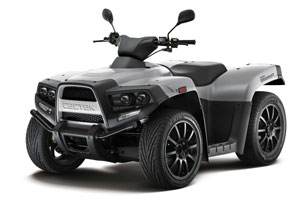
One of the best examples of this new breed is Advance Power Investment Co., Ltd. (CECTEK, formerly known as China Engine Corp.), the largest automotive-engine developer and manufacturer in Taiwan that has been also actively diversifying its business scopes into powersports products.
The firm's Quadrift on-road and new Kingcobra sport all terrain vehicle (ATV) models, powered by CECTEK's 500cc high-performance engine, turned the heads of many visitors at the show due to their special features and styling designs.
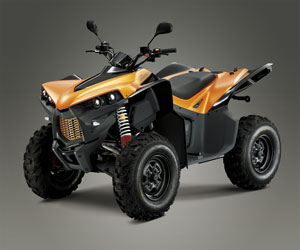
CECTEK began shipping ATV models with electronic fuel-injection (EFI) 500cc engines in June. The four-stroke, single-cylinder ATV delivers a power output of 30 kilowatt (kW) at 6,500 rpm and a 44 Nm torque at 4,500 rpm.
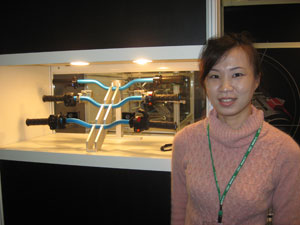
The Quadrift is unique among ATVs in that it was designed specifically for on-road use. The vehicle's ultra-secure chassis system (UCS) delivers superior on-road maneuverability and security, while the fully independent four-wheel suspension with free preload-adjustable shock absorbers add to driving fun. The Quadrift has a non-centrifugal clutch continuous variable transmission (CVT) system with engine-braking function, as well as a two-position transmission for switching the rear differential between limited-slip and security modes.
The Quadrift has aluminum wheels and low-profile high-speed tires for achieving superior on-road performance; dual large-diameter front (250mm) and rear disc brakes; and a racing instrument panel with multi-function liquid crystal display (LCD) display.
The Kingcobra has an eye-catching design and plenty punch as well. CECTEK claims that the powerful 497cc powertrain on the vehicle makes it a leader of the pack.
The single-cylinder, four-valve, liquid-cooling engine equipped with close-loop EFI system provides efficient, smooth, and reliable power for all application. The valve-train system has been carefully designed with software assistance and drawing on CECTEK's extensive know-how in automotive engine technology. CECTEK developed this engine specifically for recreation and powersports applications. The sturdy engine structure, high efficient cooling and lubrication systems, quality components ensure exceptional reliability in this powertrain.
The powerful powertrain integrates park, reverse, neutral, high, low, and 2wd/4wd gears into the very compact crankcase, which also simplifies the maintenance. The engine meets the updated 2002/51/EC directives.
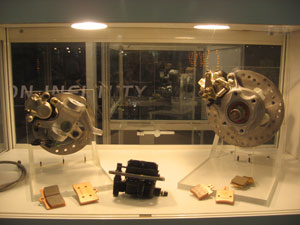
Established over 40 years ago, KT-Motor Industry Co., Ltd. is the leading manufacturer of handlebar levers and combination switches for motorcycles, scooters, and ATVs in Taiwan. It has been aggressively developing newer and better products to win orders from an increasing number of global major motorcycle brands, as well as diversifying product lines into higher technical-threshold fields.
At the 2008 INTERMOT Cologne, KT-Motor showcased many of its high-end products developed for leading PTW brands. The line-up included 2WD/4WD shift switches with lock functions to prevent mis-touching (for Yamaha ATV models), a mechanical switch for third brake lights (for Polaris, Arctic Cat, Bombardier, etc.), and a fully water-proof, electronic combination switch for BMW GS450 dirt bikes.
The aggressive company has also diversified into the high technical-threshold brake-caliper field by pairing up with an Italian partner. The two parties have poured about two million euro into a new joint venture to develop and make high-end brake calipers for PTWs and ATVs.
KT-Motor sales manager Sophia Lin claims that her company has been upgrading design, development, and manufacturing capabilities to tap high-end markets where price competition is weaker from rivals in lower-cost nations. One of KT-Motor's ongoing projects, she discloses, is the development of a high-end combination switch model with nine functions sized for the small area of a handlebar.
Lin says that her company has installed most advanced clean-room production lines to produce high-level products for major global powersports brands.
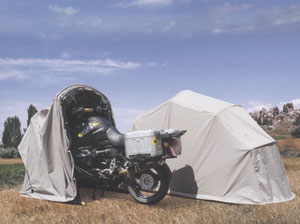
The Turbo Bike Home developed by Sportsman Corp. was one of the most innovative accessories displayed at the show. This sturdy, light-weight motorcycle cover/tent has a unique tilting-structure and can be set up in a jiffy, thus the "Turbo" name.
One of the most experienced camping tent makers in Taiwan, Sportsman tapped the motorcycle tent/cover market to escape low-price competition in the camping tent market from rivals in mainland China.
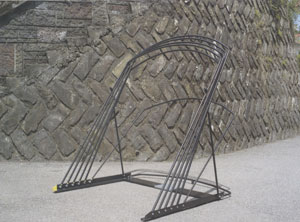
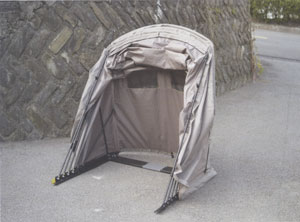

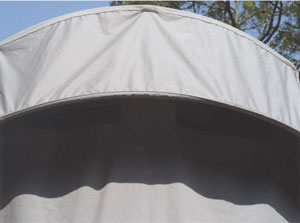
The Turbo Bike Home has a radius-frame structure designed for quick and hassle-free operation. The cover fabric is made of super water-repellent "Rispstop" poly-cotton cloth weighing only 230 grams per square meter.
Sportsman also offers a larger tent/cover called the "Turbo Motor Home" for automobiles. Measuring 530cm x 250cm, the tent has side cloth doors for easy vehicle entry/exit. There are also two wheel stops inside.
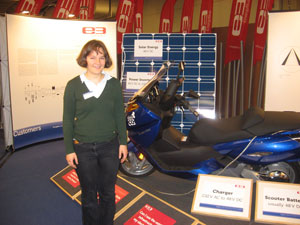
USB Standard in LEV: EnergyBus
Also on display at 2008 INTERMOT was the EnergyBus standard, founded in Taiwan by the Industrial Technology Research Institute (ITRI) and ExtraEngergy, a non-profit organization headquartered in Tanna, Germany, to integrate standards for connecting electric components, such as numerous battery and plug types, of light electric vehicles (LEVs) powered by electricity under 50V.
ITRI is the leading industrial-technology research hub in Taiwan and ExtraEngergy is a non-profit organization headquartered in Tanna, Germany, with activities focused on independent information, promotion and testing for LEVs around the globe.
Yang Mo-hua, chief technology officer of HiTech Energy Inc. of Taiwan, and president of EnergyBus e.V. of Germany, has been a leading developer and cheerleader for the EnergyBus standard. EnergyBus e.V. is a non-profit association, a platform for institutions and industry representatives to work together on the development and market introduction of EnergyBus. EnergyBus e.V. was founded in 2007 in Taiwan and is based in Germany.
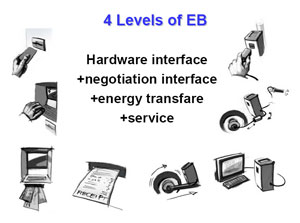
Melanie Wiederkehr, project manager of EnergyBus, points out that the EnergyBus standard consists of a standardized set of connectors, which safely link LEV electric components, such as batteries, chargers, motors, sensors, and human interfaces. These components communicate with each other on a CAN-based protocol. The uniform exchange of information enables the components to operate at maximum performance.
According to Wiederkehr, the EnergyBus standard enables energy and service data to be safely transmitted simultaneously through the same connector. "We are trying to map out an intelligent data/power/communication protocol for the LEV industry, just like the universal serial bus (USB) standard for the personal computer (PC)," she says.
The EnergyBus standard has several goals, Wiederkehr explains. First of all, it aims to resolve many problems that the LEV industry is facing as it grows, especially compatibility and safety issues. Second, the standard hopes to make components more compatible to achieve faster and more efficient product development and expand the range of product choices for high-quality vehicles on the market. Third, EnergyBus aims to be the basis for designing public LEV infrastructure such as rental stations, or swapping machines without the monopoly of a single manufacturer. Fourth, EnergyBus aims to pave the way for LEVs to enter the mass market.
According to Wiederkehr, the LEV industry is in the same situation as the computer industry before the introduction of the USB standard. Components of different manufacturers could not be used together, so when one device changed, all the others had to be adapted, costing time and money. "ExtraEnergy and ITRI decided to step in and enhance communication and development together with other industry players to resolve the lack of a common standard in the LEV market," Wiederkehr says.
"The CAN-bus has revolutionized the car industry, the USB standard has revolutionized the computer industry, and the Bluetooth has revolutionized the cellphone industry," Wiederkehr says. "EnergyBus will do the same in the LEV line."
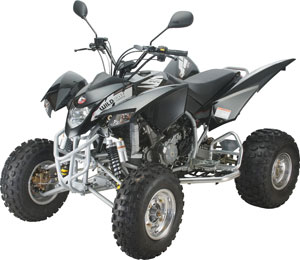
Standard Motor Corp. (SMC) is a medium-sized powered two-wheeler (PTW) and ATV makers in Taiwan. Like many counterparts on the island, the company has faced fierce price-cutting competition from rivals in mainland China, forcing it to find niche markets to survive.
James Kuo, vice general manager of SMC, says that his company has long been the largest gear-shift ATV manufacturer in Taiwan. The company therefore chose to stay in this niche and focus on developing newer and better models.
One such model is a wide-array gear-shift ATV product called the RAM500. This sport ATV model has a 500cc engine supplied by Fuji Heavy Industries. According to Kuo, the RAM 500 is the highest-end model produced by SMC. In addition to its advanced gear-shift transmission system, the RAM 500's mono-suspension mechanism features special-developed connection-bar design and Taiwan's-first dirt-bike-like dampening sub-system.
"We put a lot of effort into every detail of the new model, including fine tuning the engine, specific-use suspension, and the advanced lock nut for reverse," Kuo claims. "In addition, the new model weighs only 195 kg (compared to approximately 230kg of same-class counterparts) thanks to the weight-cutting vehicle-frame design."




